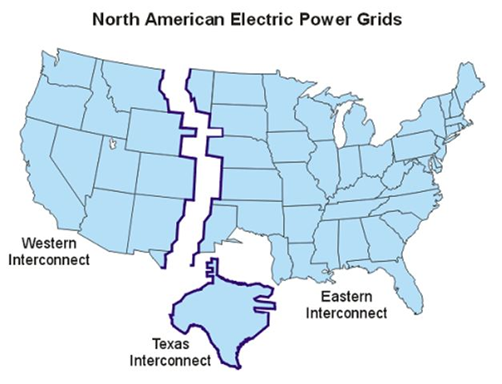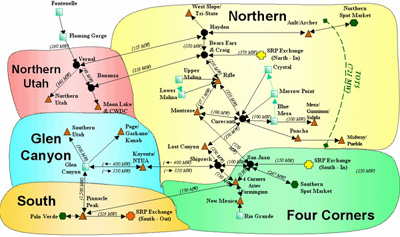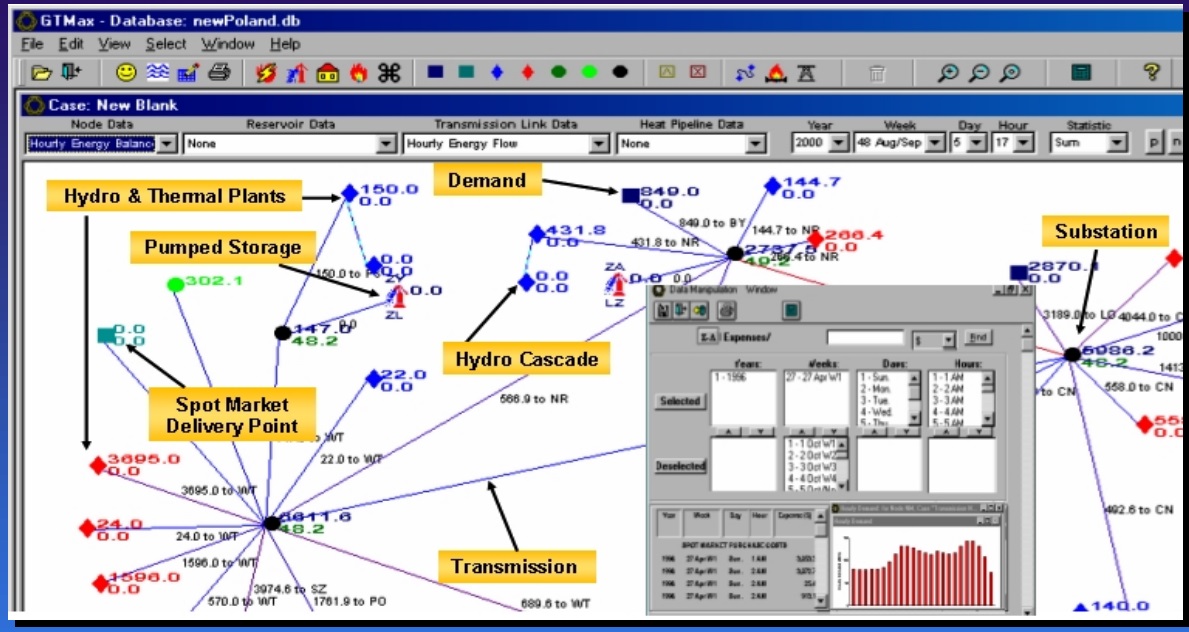Difference between revisions of "GCDAMP- GTMAX"
Cellsworth (Talk | contribs) |
Cellsworth (Talk | contribs) |
||
| (6 intermediate revisions by the same user not shown) | |||
| Line 24: | Line 24: | ||
|style="width:60%; font-size:120%;"| | |style="width:60%; font-size:120%;"| | ||
| − | WAPA and Reclamation | + | WAPA and Reclamation uses Argonne's GTMax model to analyze the economics of CRSP hydropower systems in the western half of the U.S. power grid (the Western Interconnect). |
*GTMax stands for '''G'''eneration and '''T'''ransmission '''Max'''imization | *GTMax stands for '''G'''eneration and '''T'''ransmission '''Max'''imization | ||
| − | *GTMax: A model used to | + | *GTMax: A model used to guide operators in how to maximize the efficiency in scheduling generation to meet electrical loads. |
|}<!-- | |}<!-- | ||
| Line 52: | Line 52: | ||
The GTMax model helps researchers study complex marketing and system operational issues. With the aid of this comprehensive model, utility operators and managers can maximize the value of the electric system, taking into account not only its limited energy and transmission resources, but also firm contracts, independent power producer (IPP) agreements, and bulk power transaction opportunities on the spot market. GTMax maximizes net revenues of power systems by finding a solution that increases income while keeping expenses at a minimum. At the same time, the model ensures that market transactions and system operations remain within the physical and institutional limitations of the power system. When multiple systems are simulated, GTMax identifies utilities that can successfully compete in the market by tracking hourly energy transactions, costs, and revenues. | The GTMax model helps researchers study complex marketing and system operational issues. With the aid of this comprehensive model, utility operators and managers can maximize the value of the electric system, taking into account not only its limited energy and transmission resources, but also firm contracts, independent power producer (IPP) agreements, and bulk power transaction opportunities on the spot market. GTMax maximizes net revenues of power systems by finding a solution that increases income while keeping expenses at a minimum. At the same time, the model ensures that market transactions and system operations remain within the physical and institutional limitations of the power system. When multiple systems are simulated, GTMax identifies utilities that can successfully compete in the market by tracking hourly energy transactions, costs, and revenues. | ||
| − | [[Image:Ceeesa ModelsGtmaxRegions.jpg|center| | + | [[Image:Ceeesa ModelsGtmaxRegions.jpg|center|600px]] <br> |
An added benefit of GTMax is that it simulates some limitations, including power plant seasonal capabilities, limited energy constraints, transmission capabilities, and terms specified in firm and IPP contracts. Moreover, GTMax also considers detailed operational limitations, such as power plant ramp rates and hydropower reservoir constraints. Currently, power companies are using GTMax to determine hourly, weekly, and seasonal power and energy offers to customers and to compute the costs of environmental legislation. GTMax can also be used to fine-tune hourly resource generation patterns, spot market transactions, energy interchanges, and power wheeling on the transmission system. | An added benefit of GTMax is that it simulates some limitations, including power plant seasonal capabilities, limited energy constraints, transmission capabilities, and terms specified in firm and IPP contracts. Moreover, GTMax also considers detailed operational limitations, such as power plant ramp rates and hydropower reservoir constraints. Currently, power companies are using GTMax to determine hourly, weekly, and seasonal power and energy offers to customers and to compute the costs of environmental legislation. GTMax can also be used to fine-tune hourly resource generation patterns, spot market transactions, energy interchanges, and power wheeling on the transmission system. | ||
| Line 154: | Line 154: | ||
*[[Media:GTMax Rpt Final.pdf |GT Max Final Products of 2011 Hydropower KA and GT Max Model review workshop]] | *[[Media:GTMax Rpt Final.pdf |GT Max Final Products of 2011 Hydropower KA and GT Max Model review workshop]] | ||
*[https://www.usbr.gov/uc/progact/amp/amwg/2010-08-24-amwg-meeting/Attach_02a.pdf AMWG presentation: Socioeconomic Workshop and Panel Report] | *[https://www.usbr.gov/uc/progact/amp/amwg/2010-08-24-amwg-meeting/Attach_02a.pdf AMWG presentation: Socioeconomic Workshop and Panel Report] | ||
| − | |||
*[https://www.usbr.gov/uc/progact/amp/pdfs/GTMaxModel/GTMax-Final-Rpt-main.pdf Final Report of the GTMax Model Review Panel] | *[https://www.usbr.gov/uc/progact/amp/pdfs/GTMaxModel/GTMax-Final-Rpt-main.pdf Final Report of the GTMax Model Review Panel] | ||
*[https://www.usbr.gov/uc/progact/amp/pdfs/GTMaxModel/Workshop-Particip-Resp.pdf Workshop participants' responses to the final report ] | *[https://www.usbr.gov/uc/progact/amp/pdfs/GTMaxModel/Workshop-Particip-Resp.pdf Workshop participants' responses to the final report ] | ||
| Line 160: | Line 159: | ||
|- | |- | ||
| − | ! <h2 style="margin:0; background:#cedff2; font-size:120%; font-weight:bold; border:1px solid #a3b0bf; text-align:left; color:#000; padding:0.2em 0.4em;"> | + | ! <h2 style="margin:0; background:#cedff2; font-size:120%; font-weight:bold; border:1px solid #a3b0bf; text-align:left; color:#000; padding:0.2em 0.4em;">Does WAPA try to maximize revenues or minimize costs? </h2> |
|- | |- | ||
|style="color:#000;"| | |style="color:#000;"| | ||
| + | |||
| + | Excerpt from the [https://www.usbr.gov/uc/progact/amp/pdfs/GTMaxModel/Workshop-Particip-Resp.pdf workshop participants' responses] to the [https://www.usbr.gov/uc/progact/amp/pdfs/GTMaxModel/GTMax-Final-Rpt-main.pdf Final Report of the GTMax Model Review Panel:] | ||
In addition to numerous references to maximizing revenues and improving profits, the author(s) state | In addition to numerous references to maximizing revenues and improving profits, the author(s) state | ||
| Line 186: | Line 187: | ||
As in items 3-4 above, the promotion of false perceptions such as this serves only to establish or | As in items 3-4 above, the promotion of false perceptions such as this serves only to establish or | ||
strengthen barriers among AMP stakeholders who might otherwise be able to collaborate more | strengthen barriers among AMP stakeholders who might otherwise be able to collaborate more | ||
| − | effectively. [https://www.usbr.gov/uc/progact/amp/pdfs/GTMaxModel/Workshop-Particip-Resp.pdf] | + | effectively. [https://www.usbr.gov/uc/progact/amp/pdfs/GTMaxModel/Workshop-Particip-Resp.pdf ] |
| + | |||
Latest revision as of 09:02, 27 August 2024
|
|
WAPA and Reclamation uses Argonne's GTMax model to analyze the economics of CRSP hydropower systems in the western half of the U.S. power grid (the Western Interconnect).
|
| -- |
-- |
-- |
|---|
|
|


